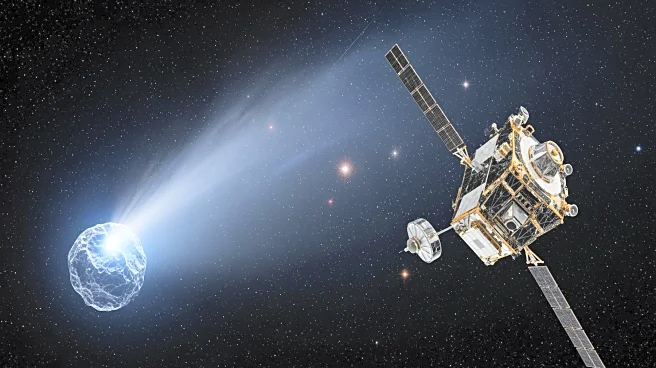What's Happening?
Astronomers have successfully captured a detailed radio view of the Milky Way galaxy, showcasing the stellar life cycle from birth to death. This achievement was made possible through the GaLactic and
Extragalactic All-sky MWA (GLEAM) and GLEAM eXtended (GLEAM-X) surveys, which utilized the Murchison Widefield Array telescope. The surveys, conducted over several years, compiled data from 28 nights in 2013 and 2014, and 113 nights from 2018 to 2020, resulting in the largest low-frequency radio color image of the Milky Way ever created. The image reveals remnants of exploded stars and regions of ionized gas where new stars are forming, with red bubbles indicating dead stars and blue regions highlighting areas of star formation. This extensive survey marks a significant milestone in astronomical research, providing twice the resolution and ten times the sensitivity of previous images.
Why It's Important?
The new radio view of the Milky Way is a groundbreaking development in the field of astronomy, offering insights into the complex processes of star formation and death. By capturing the galaxy in radio wavelengths, astronomers can penetrate the thick clouds of dust and gas that obscure visible light, allowing for a clearer understanding of the galactic plane. This enhanced view aids in distinguishing between different celestial objects, such as pulsars and planetary nebulae, and provides valuable data on the interactions and evolution of stars. The findings have implications for future astronomical research, as they set a new standard for sensitivity and resolution that only upcoming technologies like the SKA-Low telescope can surpass.
What's Next?
The completion of the SKA-Low telescope, an array of tens of thousands of radio antennae, is anticipated to further advance the study of the Milky Way by providing even greater sensitivity and resolution. This development will enable astronomers to explore previously unobserved regions of the galaxy at low frequencies, potentially uncovering new phenomena and enhancing our understanding of the universe. As researchers continue to analyze the data from the GLEAM and GLEAM-X surveys, they may identify additional radio sources and refine models of stellar evolution, contributing to the broader field of astrophysics.
Beyond the Headlines
The radio view of the Milky Way not only advances scientific knowledge but also highlights the collaborative efforts in the field of astronomy. The project involved international teams and significant technological investments, underscoring the importance of global cooperation in scientific endeavors. Additionally, the ability to observe the galaxy in radio wavelengths opens up new possibilities for studying other cosmic structures, potentially leading to discoveries beyond our own galaxy.











